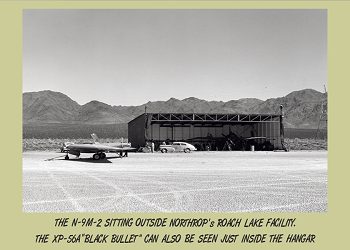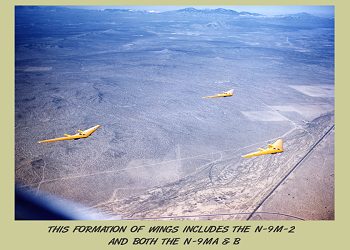
 |
Jack Northrop secured permission to erect a small hangar at Roach Lake, Nevada, just across the state line. The rudimentary facility was used to house the N-9M-2, XP-56A, and MX-324 for three months.
Northrop test pilot Alex Papana checked out the N-9M-2 at Roach Lake on 3 March 1944. By 31 March 1944, the N-9M-2 had completed 33 flights and accumulated 23 hours and seven minutes of flight time. The results were rapidly assimilated into the design of the XB-35.
On 19 April, several Army Air Force pilots arrived from Wright Field to fly the N-9M-2. According to Northrop photographer Roy Wolford, the Army men argued about who would be first to fly the airplane. Maj. Perry J. Ritchie ended the argument by walking out to the N-9M-2 and climbing into the cockpit.
 |
As the dust cleared, the pilot climbed out of the cockpit and began to walk toward the distant hangar. Then, as if it were an afterthought, he returned to the plane and casually set the landing gear switch to the DOWN position.
Wolford documented the damage for posterity. The disgruntled Northrop crew hoisted the airplane up and lowered its landing gear. Finally, the N-9M-2 was towed back to the hangar for repairs. Most of the damage was to the belly panel, landing gear doors, and propellers. Fortunately the Northrop mechanics were able to complete all repairs at the Roach Lake facility and return the N-9M-2 to flight status.
The N-9M-2 incident was not Maj. Ritchie's first airplane accident, nor would it be his last. He had previously crashed a P-39, XAT-13, and a P-47C. The latter, in July 1943, resulted in the longest freefall parachute drop to date. Just five days after the belly landing at Roach Lake, Ritchie was killed when the NA-98X (a modified B-25) disintegrated in mid-air at Mines Field, California.
|
|
